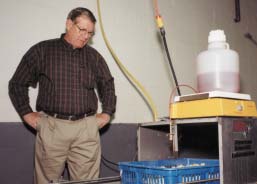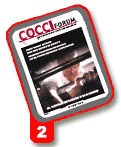COCCI Focus - Peace of Mind
Switch to coccidiosis vaccine yields flexibility, performance for rapidly growing Peco Foods

Bowman: 'It seems like we get a
boost when we go off the ionophore
and switch to the vaccine.'
|
Van Bowman remembers being
concerned when he would
switch his larger birds to coccidiostat-
free withdrawal feed 7 to 10
days before marketing, hoping they
wouldn't break with coccidiosis en
route to their finish weight of 6.5 to 7
pounds.
The live operations manager at Peco
Foods, Sebastopol, Miss., had good reason
to be concerned.
Medications, even low-cost ones,
can get expensive when fed to today's
larger birds. Resistance buildup was
another issue.
"We were at a point where only one
ionophore, salinomycin, was getting
the job done "and I was concerned
about that one eventually running out
of steam as well," he says. "And we
never had much success rotating anticoccidials
to improve performance.
We'd use nicarbazin for a while, but we
can't use it in the summer and there are
also export concerns with birds fed that
anticoccidial."
Pulling the Coccidiostat
In 1998, tired of resistance issues,
export concerns and the looming threat
of coccidiosis breaks, Bowman pulled
traditional anticoccidials from the feed
and tried managing the disease with a
one-dose vaccine that protects against
five species of Eimeria for the life of
the bird.
"We were a little nervous about it at
first," he admits. "But with the new
spray cabinet technology, the vaccine,
Coccivac-B, is distributed uniformly
and we're getting excellent control -
as good or better than what we've had
with any in-feed product. In terms of
cost, the vaccine broke even with salinomycin."
There was one additional benefit
that Bowman hadn't anticipated: Peace
of mind.
"Because the vaccine protects
against coccidiosis for the lifetime of
the bird, I don't have to worry about
birds breaking with disease as they get
older," he says. "Vaccination also gave
us an opportunity to give one of the
few coccidiostats we have left a much
needed rest."
Bowman also thinks vaccination has
improved performance of his overall
coccidiosis-management program. "It
seems like we get a boost when we go
off the ionophore and switch to the
vaccine," he says. "Likewise, the
ionophore works better after it's been
given some time off."
In the field, broiler serviceman
Rusty Thaggard says Peco's contract
growers have also been pleased with
the vaccine's performance.
"It's been very successful," says
Thaggard, who supervises 21 of the
company's 120 contract farms near
Sebastopol. "The birds' performance is
every bit as good or, in some cases,
better than when they were fed an
Bowman: 'It seems like we get a
boost when we go off the ionophore
and switch to the vaccine.'
"Without the drug, there was one
less hassle, one less worry."
Initially, Peco used the vaccine for
three cycles beginning in spring, then
followed with feed treatments for the
next two to three. The company is now
considering extending the vaccine to
four cycles.
"The coccidiosis vaccine could be
used year-round, but from a milling
standpoint, it just happens to work best
for us if we get it in the spring,"
Bowman explains. "On the small bird,
for instance, we still like to use nicarbazin
in the winter. The cycling just
works best for us from a physical
standpoint, but I don't think timing
would matter in terms of performance."
Feeding for Performance
The switch to vaccination has also
allowed Peco to remain more flexible
with its nutrition program and feed
birds for optimum efficiency and return
on investment.
"The length of feeding a certain
broiler feed or a regular coccidiostat
and drug program is dependent on the
coccidiostat being used, the dietary
inclusion rate of the coccidiostat, and
the growth-promoting drug being used
in conjunction with the anticoccidial -
plus the nutrient profile of the feed in
relationship to the age of the bird," says
Peco's consulting nutritionist Dr. Rex
Bushong, San Angelo, Tex.
"The use of Coccivac-B allows
changing feeds without regard for coccidiosis
challenge, immunity and bird
age, and FDA drug regulations."
Adds Bowman, "With the vaccine,
we can build our nutrition program
around the birds' needs, not some predetermined
drug regimen," he says.
Peco keeps its feed costs confidential,
but Bowman says the company's
feed profile is "very competitive."
"The feed profile for our larger birds
"that is, the dollars and cents we put
into our feed vs. performance "is
now among the best in the country in
Agristats," he adds, referring to an independent
industry survey comparing
production costs and performance of
U.S. poultry companies.
Aiming for Four Cycles
Looking to 2001, Peco expects to start
using it in four consecutive cycles on
farms linked to its Sebastopol operation,
which places 660,000 birds per
week. "We've been running some trials
at one of our complexes and the numbers are looking pretty good," he says.
The company also plans to use the
vaccine in its recently acquired
640,000/week operation in Philadelphia,
Miss., where they produce
smaller birds weighing 5 to 5.5 pounds.
Bowman says he initially had some
concerns about using the vaccine in
birds fed to lighter weights because of
the "knock down" in feed efficiency
and growth that can happen the first
week or two after coccidiosis vaccination,
which introduces live oocysts into
the birds. Larger birds have time to
recover.
"But I talked to a vet at another
poultry company who was using it successfully
in birds fed to only 4 pounds,
and they had good results with vaccination,"
he says.
This spring Bowman says they may
back off salinomycin early and try
Clinacox™ (diclazuril), a synthetic
anticoccidial that recently received
combination clearances in the United
States with the growth enhancers bacitracin
methylene disalicylate, bambermycin
and virginiamycin.
"From the data we've seen, I'd be
inclined to use Clinacox as a clean-up
product for one or two cycles before
going on the vaccine," Bowman says.
Vaccinated birds have also remained
free of clostridial enteritis. Bowman
thinks it's important to keep a growth
promotant such as virginiamycin in the
starter and grower rations to protect the
gut and ward off enteric problems.
"But as time goes on, I think we'll
also see less and less antibiotic usage in
chickens," Bowman predicts. "We see
what's happening in Europe, and the
FDA is already talking about banning
more antibiotics here. We're not trying
to produce a drug-free bird at this time,
but we're exploring our options so
we'll be ready. Coccidiosis vaccination
lets us meet that demand without com-
Overcoming the Fear
Afraid to try coccidiosis vaccination because of
the confusion it might cause at the feed mill?
"That's a cop out," insists consulting nutritionist Dr.
Rex Bushong. "Switching to a coccidiosis vaccination
program should pose no problem to a feed
mill, provided the mill has a competent manager
and a good staff." |








